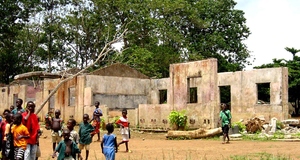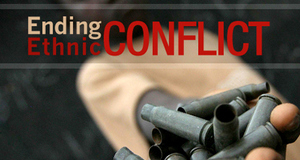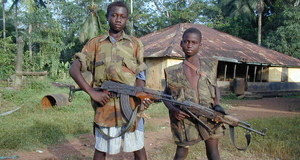Featured Article:Idle Youth: Using Sport to Address the Youth Bulge in Sierra LeoneSport as a Transferable Medium of Engagement Suitable for Fractious Social EnvironmentsI will divide this chapter into distinct sections. Firstly, I will endeavour to fully clarify the first assumption underlying this paper, namely how sport can replicate war to a certain degree and therefore both ease the reintroduction of combatants into the weave of the social fabric and simultaneously reinvigorate civil society. Secondly I will demonstrate the benefits of social inclusivity that sport encourages. Thirdly I will highlight how sport can and has served as a tool in its own right to plug the gaps in the Sierra Leone’s fledgling government’s schooling system and provide both health and education services that afford it a special status as promoting truly holistic development. Colin McInnes has argued that the west has become physically removed from modern warfare. The increasingly localised and intra-state nature of war, especially in Africa, has rendered the richest and most powerful nations detached from their realities and largely unable to settle their outcomes as they had done with relative ease until the 1960s.49 This has reduced the west to the role of bystander within the complicated triadic nexus of bystander, executioner, and victim. This has various impacting consequences. Negatively, the consequence of this new and largely passive role is that the West finds itself unable to significantly engage with fragile and failing states and as such is able to prevent conflicts relapsing within five years only fifty percent of the time.50 The wider regional and global impact of these new wars makes the need to engage with failed, failing, or fragile states of absolutely the highest importance, with Mark Duffield correctly remarking that the mantra of ‘letting them fight it out amongst themselves’ is no longer a viable option from ‘either an altruistic or realistic perspective.’51 However doing so in an unobtrusive, economical and yet meaningful way is not easy.I have already mentioned the disconnect between bottom up and top-down policies and will not repeat them here, but in addition to these there is a troubling gap between aid policy and practice that hinders the transition from short-term emergency relief to genuine long-term development. Better policy directives and implementation guidelines must dictate aid allocation and methods of distribution. Perhaps the first principle should be Mary Anderson's 'Do no Harm': Aid misuse has wide reaching negative social and economic impacts, and the primary concern should be at the very least not make things worse.52 Yet by-products of aid such as embezzlement or horizontal inequality show that this concern is not considered enough. Therefore from a wider viewpoint, ensuring four dimensionary policy coherence within the internal departments of each aid agency (internal); across the different aid agencies (harmonisation); between donor and recipient governments (alignment); and from those recipient central governments out to their more rural and disparate provinces (whole of government) will not only 'do no harm', but will in fact augment the efficacy of aid in general. It is a question of designing the right policies and establishing the right channels of dialogue to facilitate more impacting results.53 Sport fits within these engagement requirements. It is a low cost, high impact and transferable medium of engagement that allows for unobtrusive western involvement and encourages safe interaction of people who may have previously felt enmity towards each other. Far from doing no harm, it actually provides a solid social framework that parodies war closely enough to resonate with communities recently affected by it. Indeed the similarities between war and sport seem to go deeper than the obvious correlations of opposing sides, victors, supporters, uniforms, and rules. Moreover it is the sense of brotherhood between the competitors, and the feeling of belonging and shared fate that gives sport real relevance in post and pre-conflict settings. In Sierra Leone, in addition to this fraternal bond there was a pervasive feeling of patrimonialism between child soldiers and their Revolutionary United Front (RUF) commanders during the civil war that ‘was founded upon something way outside the fighting group, [something] within Sierra Leonean society,’54 and Olonisakin notes how ‘Foday Sankoh, the head of the RUF, was fondly called “Papay” by his juvenile followers.’55 However, as Peace Commissioner Dennis Bright dejectedly summed up in 2001, these bonds were afforded the space to form because ‘the only parents [these children] have now are their bush commanders.’56 Yet this notion of patrimonialism in the field is one that mirrors the idea of a sports coach on the pitch and hence provides a hierarchical structure that is easily understandable for former combatants. Therefore just as RUF commanders supplanted the biological fathers of many Sierra Leonean children during the war, so too can inspirational teachers and coaches during peace. Better still, these familial replications can be positively channelled towards improving tolerance and harmony within society for the greater good of the country as a whole. Martin van Creveld is certain in his deduction that ‘in so far as war, before it is anything else, consists of fighting– in other words, a voluntary coping of danger– it is the continuation not of politics, but of sport.’57 If we were to reverse this logic that war is the violent continuation of sport, then it would appear fair to assume that, by replicating war, sport can be the medium to encourage its peaceful discontinuation or prevention. It is so effective for four reasons. Firstly, because sport, like war, is governed by norms that reflect society’s expectations about how it should be conducted, ‘the behaviour of combatants or sports competitors cannot be divorced from the society they represent.’58 As a result sport provides a viable medium through which to alter societal perceptions that can in turn permeate and improve behavioural patterns. Hence in sport projects in Sierra Leone, enormous emphasis has been placed on encouraging tolerance and fair-play amongst the youth that transcend the sports pitch and in fact pervade society itself. Secondly, sport is closely attached to the notions of loyalty, community, and national identity. Spectators become involved by identifying with participants and vicariously experiencing their emotions. But individual spectators also identify with larger bodies of spectators which ‘provides a communal experience that transcends other social barriers.’59 Such collective behaviour supports Jean Michel Faure’s conclusion that sport is a ‘ritual representation of confrontation’60 which, if played within the rules and expectations set by the society in question (as described in point one), can diffuse social tensions and foster unity en masse. The third point concerns itself with the difficulty of engaging in development practices highlighted by McInnes. The changing nature of war and what is actually expected from the West means its methods of engagement have to adapt accordingly. These expectations hinge on what is really understood by the word ‘development.’ It is a contested and flexible term that has embodied a number of conflicting practices since its real entry into the global lexicon after the Second World War. The raw pursuit of ‘economic development’ seen in the thirty or so years after 1945 can largely be said to have been synonymous with the belief in the remedial qualities of pursuing ‘modernity.’ The relative failure of this approach has resulted in the current prevalence of a more encompassing definition of development that is considered ‘more than just economic progress measured on a national scale.’61 The term ‘development’ now incorporates social and environmental betterment, and improvements with regards to the protection of human rights, the provision of education, and the rule of law. Consequently, as the scope of what exactly is meant by development increases, and with it too the respective expectations of Western assistance, so too does the need for new approaches both in the field and in policy making. I argue that owing to the suitability of sport defined in points one and two, sport for development programs can bridge this engagement gap and provide the medium for impacting initiatives that work towards improving all of these different facets of development in Sierra Leone. More importantly, the popularity of sport programs in Sierra Leone mean they easily occupy and placate the bulging and potentially dangerous youth. Right To Play’s Program Manager, Moses J. Johnson, spelled out one such positive intention and result of sport programs amongst the youth: ‘Sport leagues encourage community spirit through local competitions between local youths that are supported by their respective friends. Prizes are awarded by local elders, and this interaction of course serves to build respect between the old and young sections of society.’62 Yet away from this more competitive side of sport is the fourth reason of why sport can wean post-war societies off of violence or dissuade potentially opposing forces from fighting: sheer inclusion promotes social harmony. McInnes may have deduced that ‘participation in sport is often associated with professionalism, physical and mental prowess, and an idealised manly virtue,’63 and Lincoln Allison may have added that, sport and war are gendered activities where the virtues expressed in both are essentially masculine,64 but Right To Play and other development NGOs in Sierra Leone harness the power of sport in a much more encompassing way and realise that participation brings more people directly into either the peace or conflict prevention process. In Sierra Leone sport for development initiatives have created young stakeholders in a society that, as we know, was suffering from youth marginalisation. The importance of this cannot be underestimated, and it is worth remembering Eric Hobsbawm who sagely noted that ‘where you see little stake in a system, you may be tempted to destroy it.’65 Given this urgency of creating stakeholders, it is perhaps sensible to look at this fourth point in more detail. Sierra Leone has an enormous youth population, yet the United Nations Children’s Fund (UNICEF) has estimated that sixty-seven percent of children do not receive even a primary school education.66 There is a complete lack of sport in schools, which is detrimental not only to the holistic development of children but also to the general level of attendance. Increasing school attendance is a crucial area sport can work towards in Sierra Leone and indeed it his has worked well elsewhere: In Azerbaijan school principles reported an increase in attendance by fifteen to twenty percent when sport was added to the curriculum; parents in western Tanzania noted Right To Play sport programs had resulted in a reduction in school dropouts; and head teachers in Dar Es Salaam reported attendance in school is higher on days when Right To Play activities are offered.67 Drawing on their experiences globally, Right To Play have therefore made a concerted effort to work with schools in Sierra Leone to use sport to entice more children into classrooms. The astonishing level of youth fanaticism for sport makes this particularly successful in getting the children though the school gates, if not entirely guaranteeing their commitment to study: ‘The new mind opium,’ writes Minister of Youth and Sports, Dennis Bright, ‘is the regular viewing of European soccer on satellite TV. Nearly every other youth in urban Sierra Leone is an avid fan of one European Football Club, with school going youth devoting very little time for studies.’68 Whilst this may indicate that sport can in fact be detrimental to the amount of time left for study, it also indicates that sport can mobilise the youth to actually attend school better than perhaps anything else. Furthermore the alternatives to school attendance, regardless of whether the attendees are studying or not, are certainly not preferable: many of Sierra Leone’s youth are, Illiterate, school dropouts eking a living from petty trading, narcotic drug peddling, prostitution and theft…There is a causal linkage between the desire for a daily fix and the proliferation of petty crime and theft. Narcotic drug abuse and slow economic growth are a lighted fuse on a ticking time bomb…Another problem of concern is the increasing number of disadvantaged and disabled young people [who are] disproportionately affected because they are more susceptible to social, cultural, economic and political upheavals.69 With regards to the inclusion of ‘disadvantaged and disabled young people’, sport can again fulfil a unique role. Outside of conventional schools, Right To Play is working in places such as Cheshire House and the SOS Children’s Village, both in Freetown, which specifically cater for children and youths with physical and mental disabilities. Their sport for development programs are specially designed to encourage self-belief and promote tolerance and inclusivity amongst the most marginalised in the community. For these programs not only significantly contribute to improving their physical health (which in itself works towards bettering the mobility, confidence and independence of the participants) but also sport and play act as distinct educational tools in their own right. To deliver this service, Right To Play have developed a four day 'Abilities First' training program for youth leaders on knowledge, skills, and attitudes for reducing social barriers imposed on people living with disabilities. Particular emphasis on all games and activities is placed on addressing stigma and discrimination. In addition these activities are pregnant with educational messages such as increasing HIV/AIDS awareness which serve to help plug the knowledge gaps sadly inherent in Sierra Leone’s youth. These lessons are pivotal to the development of these often neglected youths and equip them with the skills necessary to facilitate a smoother entry into mainstream society. In this way sport can be seen to work to cut across the physical barriers between the mainstream and marginalised sections of youth in Sierra Leone. This contributes not just to the development of Sierra Leone’s youth but also the country as a whole. With holistic development in mind Right To Play also recently teamed up with Insight, a media for development NGO, to make a short documentary about these two remarkably successful schools. Both sport and media empower these youths in a way that is not usually possible in their difficult environs. Crucially this makes them stakeholders in their own development programs, which is in line with the governmental objective of ‘reducing the number of marginal and increasing the number of mainstream youth.’70 The same can be said of the diverse work of Save the Children in Sierra Leone. Emmay Mah, their Freetown project manager, told me how ‘sport can provide a protective environment, and through interaction encourage independent expression– and this expression improves their chances in the future of securing better human rights.’71 As with Right To Play, these sporting initiatives are bolstered by theatrical programs. By dramatising sensitive issues it is easier for children to understand and approach them, and, especially in the case of Save the Children, such dramatics act as an indispensable medium for raising youth awareness of advocacy issues. The power of sport and dramatics lies in their ability to engage the most neglected and vulnerable sections of society– this familiarises average, able bodied citizens with those who are less able, which resultantly encourages tolerance, compassion, and furthermore multiplies the self-confidence in traditionally marginalised or peripheral members of Sierra Leone’s citizenry. Hence sport and dramatics are inextricably involved in the new, more rounded attempts at development that aim for much more than merely economic advancement. These four determinants set sport apart as conflict preventative in its own right. If we accept that violence occurs where youths feel abandoned,72 then we must also acknowledge that as sport for development programs in Sierra Leone are vehicles for inclusivity, they are conflict preventative; and given that we know from Mary Kaldor that violence frequently occurs where no civil society apparatuses are in place to provide forums for non-violent conflict mediation,73 sport should be regarded as conflict aversive not only because it affords society these interactive forums, but more crucially because it teaches the volatile youth the invaluable skills needed to use these forums peacefully. Right To Play’s innovative ‘Live Safe Play Safe’ program is evidence enough of this. Specially created games carry educational and life-relevant messages that serve both to sensitise the participating youths and children to delicate issues such as HIV and AIDS, and also instil in them qualities such as the confidence to resist peer pressure; the sense to rise above prejudices based on ethnicity or gender; and the enjoyment of life to envision hope in the future. Ruth M. Davies, the Right To Play project assistant in Freetown, grasped this fully, saying, ‘sport is fun, but sport for development aims at much more than that. There are specific messages in sport that are the really important things.’ Perhaps given its post conflict setting, the most critical message for Sierra Leonean youths surrounds the importance of acceptance. This has a much more impacting effect than just promoting fair-play on the sport’s field. In many places sport is both the medium for interaction and the vehicle for the moral and practical education for Sierra Leone’s youths. For example Emmanuel M. Conteh from War Child adds that, ‘the wider impact of the lessons of fair play, humility and magnanimity in defeat are transferable to elsewhere, for instance accepting political decisions peacefully and with tolerance.’74 Indeed already after only six or so years of peace the improvements in society resulting form sports projects are evident. Moses F. S. Kargbo is currently Senior Sports Officer in Charge of Football, and the senior representative for the Ministry of Education, Youth and Sports in the Northern Province of Sierra Leone. He is an ex-national team player, and formerly head coach of both the men’s and women’s national teams. Speaking frankly on the importance of gender inclusion, he iterated the dangers of neglecting youths, and the tendency to violent exit strategies that spawn from marginalisation. ‘Hence,’ he commented, ‘new programs are more aimed at creating harmony, and engaging youths in communal, meaningful activities.’ He also spoke of the huge gains made in recent years: Results are encouraging. There are many women’s and disabled teams throughout Sierra Leone, especially in the Northern Province. Interestingly enough the quality of these teams increases the further one goes from the city because there is less to do as you radiate out. Sport allows boys and girls to do things in common. Given the recent history of sexual violence during the civil war, this is an important measure on its own with regards to narrowing the gender divide and reducing stigma. Plus when these sport activities have adjoining educational lessons such as sexual health education, this can only be a good thing: Children learning about taboos together sensitises each child to each others’ differences be they religious, physical, ethnic, linguistic, or gender based. 75 Yet it has not always been easy to include girls in this process. In the immediate post-war years there was taboo about girls playing sport, it being commonly perceived that it ‘emasculated them.’76 This was made more problematic in the Islamic communities of Sierra Leone which were bound by the decree that women and girls should not bare their legs. Whilst this may not immediately appear a significant factor, this serves to visibly differentiate children along religious lines which is counterproductive to the notion of inclusivity and equality. From a solely physical point of view, restrictive clothes hinder the efficacy of meaningful exercise in a country with an average temperature of twenty seven degrees Celsius.77 That being said, there is a strong argument here that having to strike a balance between sport participation and Sierra Leone’s religions and customs teaches the children and youths more than a modicum of cultural and religious respect and understanding. Either way, the growing acceptance of girls and women playing sport both locally and nationally is a sign that, for the current youth generation, gender taboos are less prevalent and notions of equality are increasing prevailing. Therefore the applicability of sport in both a conflict preventative and post-conflict setting must be seen as three pronged. Firstly, sport’s ability to replicate elements of battle and parody some of the experiences found in war is a crucial factor as to why sport resonates so profoundly in post-conflict areas. This blurring of sport and war experiences make the former an ideal surrogate to war itself for the more competitive masculine ex-combatants in particular. Secondly sport can concurrently promote gender and social equality through mass participation which serves to include a broad spectrum of society in either the respective conflict prevention or post-conflict rebuilding processes. Thirdly, in Sierra Leone just as everywhere, not all children are academically minded, but sport can reach these children and youth where the classroom is not always able to. It engages them in a beneficial way and provides them with education, health and life skills that they would otherwise not have received. Most tellingly, if we place these three prongs within the ‘Exit, Voice and Loyalty’ paradigm, all can be said to promote belief in the value of voice above exit as the principal agent of social change. The next very short chapter will show how continuing and sustaining these evident improvements depends upon better planned and executed policies.Continued on Next Page » Suggested Reading from Inquiries Journal
Inquiries Journal provides undergraduate and graduate students around the world a platform for the wide dissemination of academic work over a range of core disciplines. Representing the work of students from hundreds of institutions around the globe, Inquiries Journal's large database of academic articles is completely free. Learn more | Blog | Submit Latest in Anthropology |


















